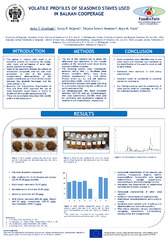| dc.description.abstract | The ageing in contact with wood is an important process for improving the aroma, color, taste and astringency of some high-quality alcoholic beverages. One of the important changes is extraction of volatile compounds (i.e. extractable compounds and gradually transformed wooden constituents) as a result of the interaction between compounds present in wood and alcoholic beverages.The aim of this study was to obtain volatile profiles of seasoned wood stave extracts and find potential markers for wood species. The following species were investigated: mulberry (Morus alba L.), Myrobalan plum (Prunus cerasifera Ehrh.), black locust (Robinia pseudoacacia L.), wild cherry (Prunus avium (L.) L.) and oak (Quercus petraea (Matt.) Liebl., and Q. robur L.). Gas chromatography with flame ionization detection (GC-FID) and gas chromatography with mass spectrometry (GC-MS) were used for qualitative and quantitative analyzes of the wood extracts, respectively.The volatile profiles of oak and other wood species were significantly different. Some of the identified compounds were proposed as potential markers for the identification of the specific wood. Oak samples were characterized by presence of many compounds, such as oak lactones, vinylguaiacol, eugenol, vanillin, propiovanillone, homovanillic acid, methyl homovanillate, syringyl propan-2-one, butyrosyringone and dihydrosynapil alcohol. In addition, isoeugenol was characteristic for pedunculate oak from Gornji Radan. On the other hand, the following compounds were characteristic of other wood samples: methylresorcinol and coumaran (mulberry); resacetophenone and o-acetyl-p-cresol (black locust); benzoic acid, 4-hydroxy-3,5-dimethoxybenzoic acid and scopoletin (Myrobalan plum); sakuranin, chrysin, tectochrysin, naringenin, pinocembrin and 2,6-dimethoxybenzoquinone and acetophenone (wild cherry). Sakuranin could be considered as potential marker for wild cherry. Our findings could be used for authenticity of wood species used for cooperage, as well as for reducing fraudulent production. | sr |


